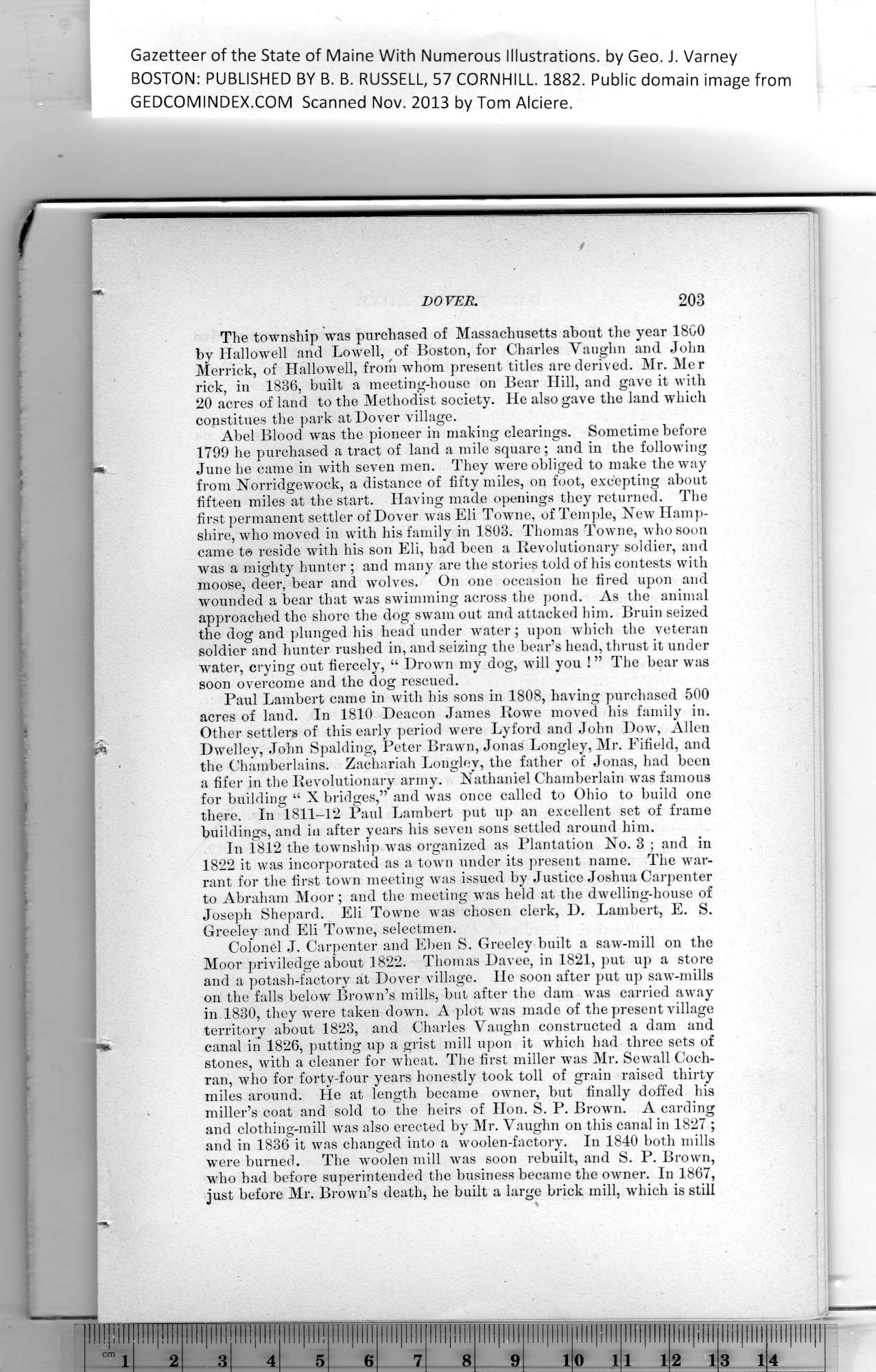|
Gazetteer of the State of Maine With Numerous Illustrations, by Geo. J. Varney
BOSTON: PUBLISHED BY B. B. RUSSELL, 57 CORNHILL. 1882. Public domain image from
DOVER.
The township w'as purchased of Massachusetts about the year 1800
by Hallowell and Lowell, of Boston, for Charles Vaughn and Jolin
Merrick, of Hallowell, from whom present titles are derived. Mr. Mer
rick, in 1836, built a meeting-house on Bear Hill, and gave it with
20 acres of land to the Methodist society. He also gave the land which
constitues the park at Dover village.
Abel Blood was the pioneer in making clearings. Sometime before
1799 he purchased a tract of land a mile square; and in the following
June he came in with seven men. They were obliged to make the way
from Norridgewock, a distance of fifty miles, on foot, exc'epting about
fifteen miles at tbe start. Having made openings they returned. The
first permanent settler of Dover was Eli Towne, of Temple, New Hamp-
shire, who moved in with his family in 1803. Thomas Towne, who soon
came t© reside with his son Eli, had been a Revolutionary soldier, and
was a mighty hunter ; and many are the stories told of his contests with
moose, deer, bear and wolves. On one occasion he fired upon and
wounded a bear that was swimming across the pond. As the animal
approached the shore tbe dog swam out and attacked him. Bruin seized
the dog and plunged his head under water; upon which the veteran
soldier and hunter rushed in, and seizing the bear’s bead, thrust it under
water, crying out fiercely, “ Drown my dog, will you ! ” The bear was
soon overcome and the dog rescued.
Paul Lambert came in with his sons in 1808, having purchased 500
acres of land. In 1810 Deacon James Rowe moved his family in.
Other settlers of this early period were Lyford and John Dow, Allen
Dwelley, John Spalding, Peter Brawn, Jonas Longley, Mr. Fifield, and
the Chamberlains. Zachariah Longley, the father of Jonas, had been
a fifer in the Revolutionary army. Nathaniel Chamberlain was famous
for building “ N bridges,” and was once called to Ohio to build one
there. In 1811-12 Paul Lambert put up an excellent set of frame
buildings, and in after years his seven sons settled around him.
In 1812 the township was organized as Plantation No. 3 ; and in
1822 it was incorporated as a town under its present name. The war-
rant for the first town meeting was issued by Justice Joshua Carpenter
to Abraham Moor ; and the meeting was held at the dwelling-house of
Joseph Shepard. Eli Towne was chosen clerk, D. Lambert, E. S.
Greeley and Eli Towne, selectmen.
Colonel J. Carpenter and Eben S. Greeley built a saw-mill on the
Moor priviledge about 1822. Thomas Davee, in 1821, put up a store
and a potash-factory at Dover village. He soon after put up saw-mills
on tbe falls below Brown’s mills, but after the dam was carried away
in 1830, they were taken down. A plot was made of the present village
territory about 1823, and Charles Vaughn constructed a dam and
canal in 1826, putting up a grist mill upon it which had three sets of
stones, with a cleaner for wheat. The first miller wras Mr. Sewall Coch-
ran, who for forty-four years honestly took toll of grain raised thirty
miles around. He at length became owner, but finally doffed his
miller’s coat and sold to the heirs of Hon. S. P. Brown. A carding
and clothing-mill was also erected by Mr. Vaughn on this canal in 1827 ;
and in 1836 it was changed into a woolen-factory. In 1840 both mills
were burned. The woolen mill was soon rebuilt, and S. P. Brown,
who had before superintended the business became the owner. In 1867,
just before Mr. Brown’s death, he built a large brick mill, which is still
PREVIOUS PAGE ... NEXT PAGE
This page was written in HTML using a program written in Python 3.2
|
